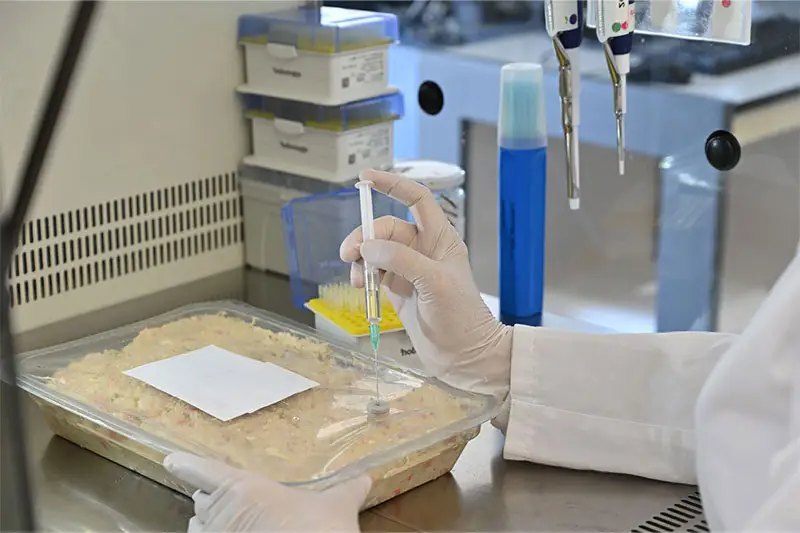Bacterial Contamination Testing in Foundation Products
In the competitive world of cosmetics, ensuring product safety and quality is paramount. Bacterial contamination can have serious health implications for consumers, which underscores the critical need for thorough microbiological testing during production. This service specifically addresses bacterial contamination testing in foundation products, a category that often comes into direct contact with the skin.
Foundation products are complex mixtures of various ingredients designed to cover imperfections and enhance skin appearance. Given their frequent use on the face, any microbial contamination can pose significant risks. Therefore, rigorous microbiological safety testing is essential to ensure consumer protection and compliance with regulatory standards.
The process begins with proper specimen preparation. Samples are collected from the foundation products using aseptic techniques to prevent cross-contamination or introduction of new bacteria. The samples are then inoculated into appropriate culture media suitable for bacterial growth, such as Tryptic Soy Agar (TSA) plates.
Once incubated under controlled conditions, any visible colonies are observed and identified using standard microbiological methods like the API 20E system or MALDI-TOF MS. This identification process is crucial to determine if the contamination includes pathogenic bacteria such as Staphylococcus aureus, Pseudomonas aeruginosa, or other potentially harmful organisms.
The testing protocol adheres strictly to international standards, particularly ISO 16170 and ASTM E2382. These guidelines provide robust frameworks for ensuring that the testing methods are reliable and reproducible. Compliance with these standards is not only a legal requirement but also enhances consumer trust in the brand.
The results of this testing are detailed and comprehensive, providing a clear picture of any bacterial contamination present in the foundation products. This information is invaluable for quality managers and compliance officers to make informed decisions about product safety and potential recalls if necessary. For R&D engineers, this data can be used to refine formulas and manufacturing processes to prevent future contamination issues.
In addition to identifying specific bacteria, the testing also evaluates the overall microbial load present in the foundation products. This is measured using methods such as total viable count (TVC) analysis, which quantifies all living microorganisms present in a given sample. The results of this analysis are reported alongside bacterial species identification to provide a holistic view of product safety.
Environmental and Sustainability Contributions
- The testing process itself minimizes waste by focusing on the most efficient means of specimen preparation and culture media usage.
- By ensuring that foundation products are free from harmful bacteria, this service helps reduce consumer health risks, thereby contributing to public welfare and sustainable consumption patterns.
International Acceptance and Recognition
The importance of bacterial contamination testing in foundation products is globally recognized. Regulatory bodies such as the FDA (United States), EMA (European Medicines Agency), and Health Canada mandate these tests to ensure that cosmetics are safe for consumer use.
Adherence to international standards like ISO 16170 ensures that our results are accepted across borders, facilitating easier compliance with global market requirements. This aligns with the broader goal of creating a harmonized approach to product safety testing worldwide.
The recognition and acceptance of these tests within the industry also drive innovation in cosmetic formulations. By meeting stringent microbial safety criteria, brands can differentiate themselves in competitive markets. This not only enhances their reputation but also opens doors for expansion into new territories.
Competitive Advantage and Market Impact
In the highly competitive cosmetics market, maintaining a reputation for product safety is key to long-term success. Bacterial contamination testing in foundation products provides several strategic advantages:
- Consumer Trust: Ensuring that your products are free from harmful bacteria builds trust with consumers and enhances brand loyalty.
- Innovation Opportunities: By continuously improving product safety, brands can explore new ingredient combinations and formulations without compromising on quality.
- Market Expansion: Compliance with international standards opens up opportunities for expanding into new markets where stringent regulations apply.
The ability to demonstrate a commitment to product safety through rigorous testing also sets brands apart from competitors, fostering a positive brand image and encouraging repeat purchases. In an industry where consumer trust is paramount, this service plays a crucial role in maintaining that trust.





